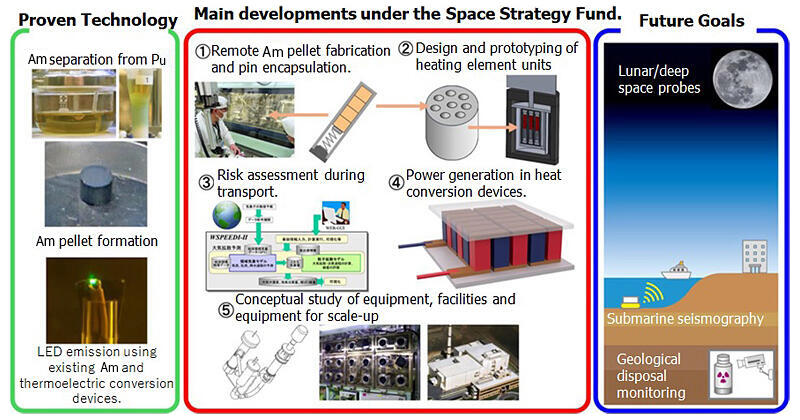A research team led by Senior Principal Researcher Masahide Takano and Deputy Technical Manager Yuta Eguchi of the NXR Development Center of Japan Atomic Energy Agency (JAEA), along with Global Zero Emission Research Center Deputy Director Atsushi Yamamoto and Research Team Leader Michihiro Ohta from the National Institute of Advanced Industrial Science and Technology (AIST), have begun research and development aimed at the practical application of an americium-241 nuclear battery that can serve as a maintenance-free power and heat source for periods ranging from several decades to 100 years. They are utilizing JAXA's Space Strategy Fund for this development. They aim to produce a prototype by early 2029. Takano explained, "We have been working on solving basic issues and demonstrations over the past 3-4 years. Americium-241, which is produced by beta decay of plutonium-241, can not only be procured domestically but also represents effective utilization of radioactive waste."

Provided by JAEA
Deep space probes like NASA's Voyager use plutonium nuclear batteries, but using plutonium for batteries in Japan is not practical. Therefore, JAEA and AIST have been conducting basic research on nuclear batteries utilizing americium that naturally occurs from plutonium in spent nuclear fuel.
To date, the group has developed technology to chemically separate americium accumulated in plutonium. They have also demonstrated the sintering of oxide pellets with stabilizing additives added to the separated americium. Furthermore, they successfully illuminated LEDs by attaching thermoelectric conversion devices to existing americium-241 sealed sources (20 grams, 2 watts of thermal output).
With the project's adoption by JAXA's Space Strategy Fund, the team will now undertake full-scale technological development aimed at the practical application of semi-permanent power sources. While the contract amount has not been disclosed, the application guidelines indicate a maximum of 1.5 billion yen. The main aspects of the development include: remotely pelletizing americium and sealing it in metal pins; completing the design of a heat-generating unit prototype that meets various requirements including impact resistance in case of an explosion, and manufacturing and assembling its component parts; establishing probabilistic risk assessment methods and creating accident scenarios for transportation; selecting appropriate thermoelectric conversion devices for americium heat sources, confirming radiation durability and considering countermeasures; acquiring power generation performance data; and conceptual studies of americium separation equipment, facilities, and installations for practical application.
JAEA does not limit the use of semi-permanent power sources to the space field. They plan to explore demand for power sources for monitoring equipment or heat sources for warming in extreme regions, the deep sea, and deep geological repositories where human access is difficult.
This article has been translated by JST with permission from The Science News Ltd. (https://sci-news.co.jp/). Unauthorized reproduction of the article and photographs is prohibited.




